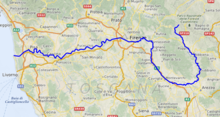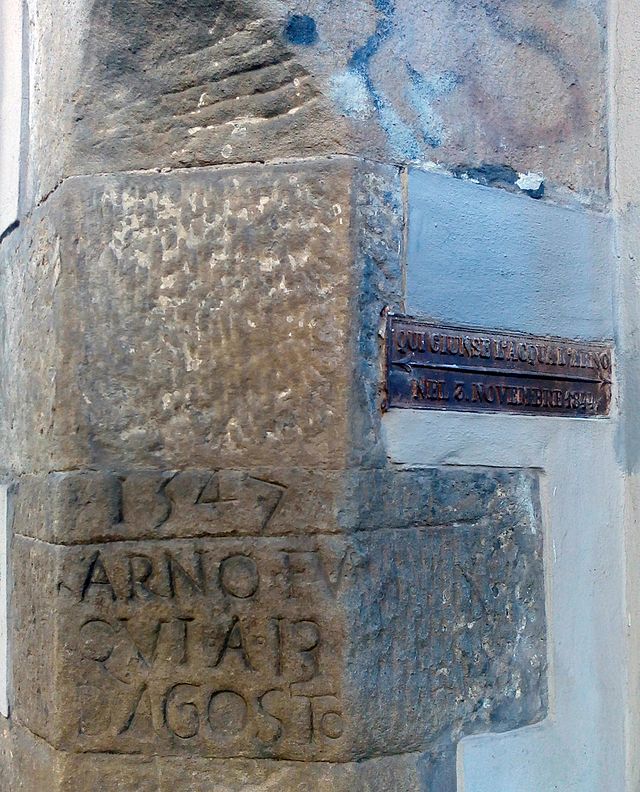Arno
Italian river in Tuscany From Wikipedia, the free encyclopedia
Italian river in Tuscany From Wikipedia, the free encyclopedia
The Arno is a river in the Tuscany region of Italy. It is the most important river of central Italy after the Tiber.[1][2]
| Arno | |
|---|---|
 View of the Arno from the Piazzale Michelangelo | |
 | |
| Location | |
| Country | Italy |
| Region | Tuscany |
| Physical characteristics | |
| Source | Monte Falterona |
| • elevation | 1,385 m (4,544 ft) |
| Mouth | Tyrrhenian Sea |
• location | Marina di Pisa |
• coordinates | 43.6802°N 10.2774°E |
| Length | 241 km (150 mi) |
| Basin size | 8,228 km2 (3,177 sq mi) |
| Discharge | |
| • average | 110 m3/s (3,900 cu ft/s) (at the mouth) |
 | |

The river originates on Monte Falterona[3] in the Casentino area of the Apennines, and initially takes a southward curve. The river turns to the west near Arezzo passing through Florence, Empoli and Pisa,[4] flowing into the Ligurian Sea[5][6] at Marina di Pisa.[7][8]
With a length of 241 kilometres (150 mi), it is the largest river in the region. It has many tributaries: Sieve at 60 kilometres (37 mi) long, Bisenzio at 49 kilometres (30 mi), Ombrone Pistoiese at 47 kilometres (29 mi), and the Era, Elsa, Pesa, and Pescia. The drainage basin amounts to more than 8,200 square kilometres (3,200 sq mi) and drains the waters of the following subbasins:


It crosses Florence, where it passes below the Ponte Vecchio and the Santa Trinita bridge (built by Bartolomeo Ammannati but inspired by Michelangelo). The river flooded this city regularly in historical times, most recently in 1966, with 4,500 cubic metres per second (160,000 cu ft/s) after rainfall of 437.2 millimetres (17.21 in) in Badia Agnano and 190 millimetres (7.5 in) in Florence, in only 24 hours.[citation needed]
Before Pisa, the Arno is crossed by the Imperial Canal at La Botte. This water channel passes under the Arno through a tunnel, and serves to drain the former area of the Lago di Bientina, which was once the largest lake in Tuscany before its reclamation.
The flow rate of the Arno is irregular. It is sometimes described as having a torrentlike behaviour, because it can easily go from almost dry to near flood in a few days. At the point where the Arno leaves the Apennines, flow measurements can vary between 0.56 and 4,100 cubic metres per second (20 and 144,790 cu ft/s). New dams built upstream of Florence have greatly alleviated the problem in recent years.[citation needed]

The flood on November 4, 1966 collapsed the embankment in Florence, killing at least 40 people and damaging or destroying millions of works of art and rare books. New conservation techniques were inspired by the disaster, but even decades later hundreds of works still await restoration.[9]
From Latin Arnus (Pliny, Natural History 3.50). The philologist Hans Krahe related this toponym on a paleo-European basis *Ar-n-, derived from the Proto-Indo-European root *er-, "flow, move".[10]
The Arno river has been strongly affected by non-native species: over 90% of fish species and 70% of macroinvertebrate species in the area around Florence are alien species.[11] These include the European catfish,[12] channel catfish,[12] Crucian carp,[11] common bleak,[13] topmouth gudgeon,[13] New Zealand mud snail,[11] and killer shrimp.[11] The mud crab has been found in the river near Pisa.[14]
Water from the Arno drainage basin is used for drinking water, irrigation, and firefighting.[15] Citizens in the central part of the drainage basin also identified flood control, support for biodiversity, fisheries, and cultural value as other services that the river provides.[15] There is the risk that flooding will jeopardize these ecosystem services, as 9% of wastewater treatment plants, 10% of landfills or other waste sites, and 4.5% of contaminated sites are at high risk of flooding, which would produce hotspots of pollution.[16]
Seamless Wikipedia browsing. On steroids.
Every time you click a link to Wikipedia, Wiktionary or Wikiquote in your browser's search results, it will show the modern Wikiwand interface.
Wikiwand extension is a five stars, simple, with minimum permission required to keep your browsing private, safe and transparent.